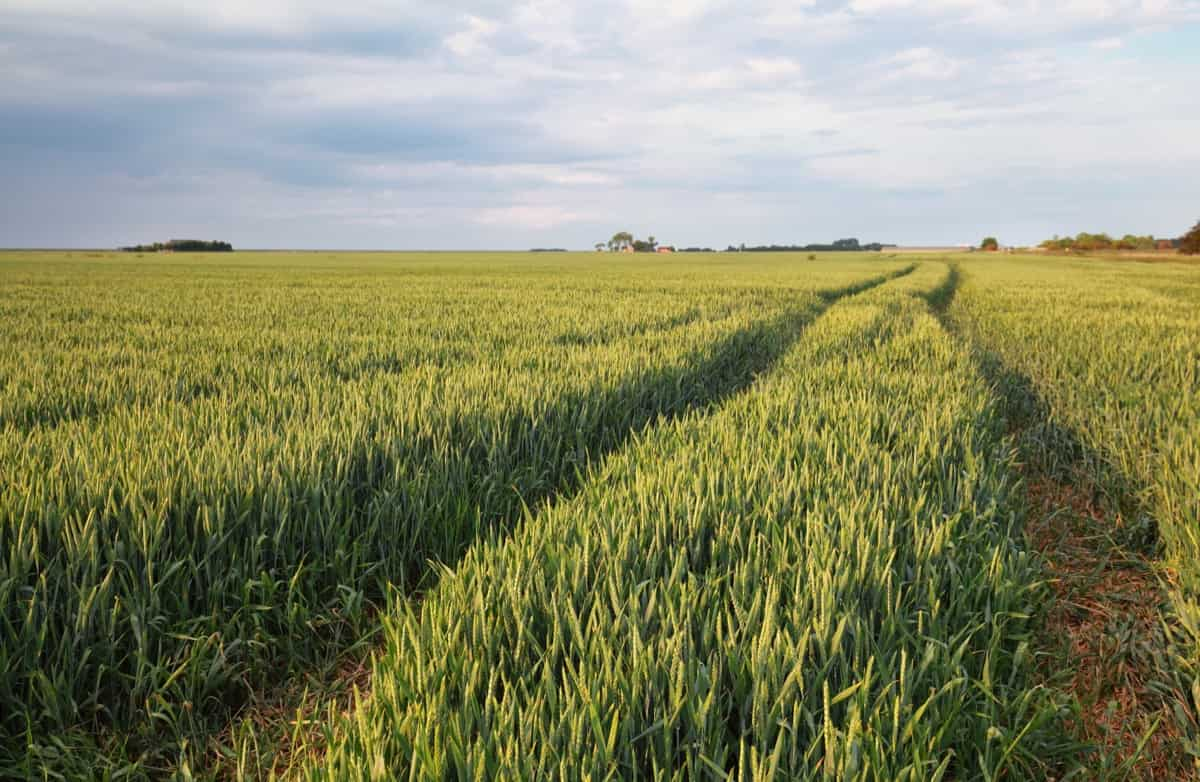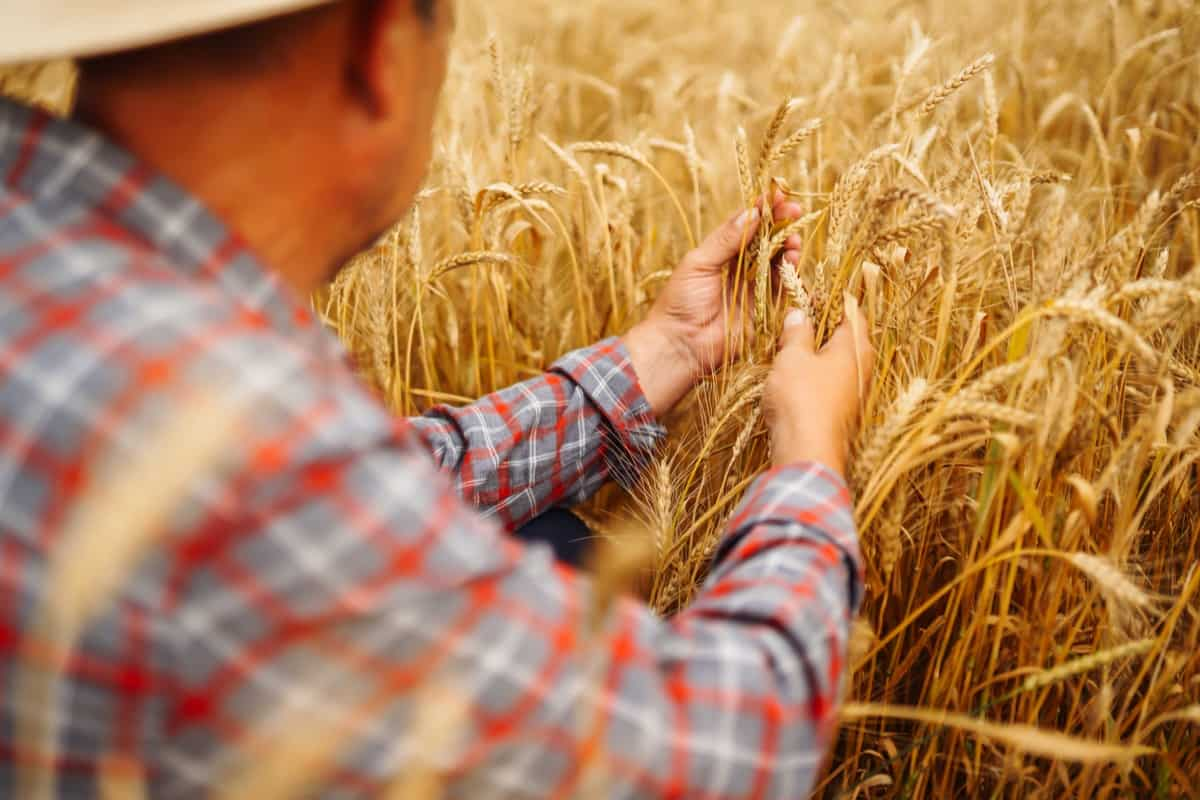Welcome to our blog on Weed Management in Wheat Farming! This article explores the crucial topic of effectively controlling weeds in wheat fields. We understand that managing weeds can be daunting for farmers, but the right strategies can lead to a bountiful harvest. We’ll delve into the latest data and summarize proven methods for weed control to maximize wheat yields. Whether you’re an experienced farmer or just starting our easy-to-read guide will provide valuable insights to tackle weed challenges head-on and ensure a successful wheat farming season.

What is Weed Management in Wheat Farming?
Weed management in wheat refers to the systematic approach of controlling undesirable plants (weeds) that compete with wheat crops for essential resources like water, nutrients, and sunlight. These weeds can significantly reduce wheat yields if not effectively managed. The primary goal of weed management is to minimize weed interference and maximize wheat productivity.
Farmers employ various weed control strategies, including cultural, mechanical, and chemical methods. Cultural practices involve crop rotation, proper planting dates, and optimizing seed rates to suppress weed growth. Mechanical methods include hand-weeding, hoeing, and cultivation to remove weeds from the wheat fields physically.
Chemical weed control involves the judicious use of herbicides that selectively target weeds without harming the wheat crop. Herbicides are applied at specific growth stages to ensure effective weed eradication. Integrated Weed Management (IWM) is a comprehensive approach combining multiple strategies to minimize weed pressure sustainably. By adopting IWM techniques, farmers can achieve better weed control and enhance overall wheat yield and quality.
Integrated Weed Management in Wheat Farming
Integrated Weed Management (IWM) is to control diverse weed species infesting wheat crops. Due to varied agroclimatic conditions, irrigation methods, tillage systems, and crop rotation sequences, wheat faces many weed challenges. With reduced height and competitiveness, modern wheat varieties have exacerbated weed issues in many regions. Weeds compete for vital resources and act as hosts for pests and diseases, compromising wheat quality and purity.
The yield losses caused by weeds range from 10 to 80%, averaging around 20-30%. In some areas, weed-related losses even reach 20% of the gross value of the wheat crop. Overreliance on chemical control has led to herbicide-resistant weeds, necessitating a holistic IWM approach. Knowing the prevalent weed species, their location, and early management actions is crucial. Keeping records of weed presence enables farmers to apply suitable pre-and post-emergence herbicides effectively.
In case you missed it: Wheat Farming with Zero Tillage: Benefits, Challenges, and Best Practices

Winter wheat faces significant weed competition during emergence and spring. For spring wheat, early-stage weed competition poses challenges. Common weed families threatening wheat crops include Asteraceae, Brassicaceae, Geraniaceae, Poaceae, Ranunculaceae, and Rubiaceae. Familiarity with weed physiology helps anticipate population shifts and tailor appropriate IWM measures.
Pre-emergence Herbicides for Weed Control in Wheat
Pre-emergence herbicides play a role in effective weed control in wheat farming. These herbicides are applied before weed seeds germinate and emerge, preventing weed establishment and competition with the wheat crop.
Metolachlor: This herbicide targets grass and broadleaf weeds, including barnyardgrass, foxtails, and pigweeds. It provides excellent control when applied before weed emergence, creating a weed-free environment for wheat seedlings to thrive.
S-metolachlor + Terbuthylazine: This combination herbicide is effective against grasses and certain broadleaf weeds like lambsquarters and pigweeds. It offers prolonged residual activity, extending weed control throughout wheat’s critical early growth stages.
Pendimethalin: Pendimethalin is valuable in wheat fields for preventing annual grasses and broadleaf weeds. It forms a barrier in the soil, hindering weed seed germination and emergence.
Post-emergence Herbicides for Weed Control in Wheat
Post-emergence herbicides are valuable tools for effective weed control in wheat farming. They are applied after wheat and weed seedlings emerge, targeting existing weed populations without harming the wheat crop. Here are three examples of post-emergence herbicides commonly used in wheat fields:
Sulfosulfuron: This herbicide belongs to the sulfonylurea group and effectively controls a broad spectrum of grassy weeds like wild oats and ryegrass. It is safe for various wheat varieties and provides selective control, minimizing damage to the wheat plants.
2,4-D: Known as a synthetic auxin, 2,4-D is effective against broadleaf weeds, such as chickweed and thistles. It is a widely used and cost-effective herbicide with systemic action, easily absorbed by leaves and roots.
Bromoxynil: This post-emergence herbicide is excellent for controlling many broadleaf weeds, including mustard, pigweed, and lambsquarters. It offers quick foliar activity and is best applied when weeds are in their early growth stages.
Metsulfuron-methyl: Another sulfonylurea herbicide, metsulfuron-methyl, targets grass, and broadleaf weeds, such as foxtail and cleavers. It provides long-lasting control and has low toxicity to non-target organisms.
Selective Herbicides for Weed Control in Wheat
Selective herbicides play a vital role in weed control for wheat farming as they target specific weed species while sparing the wheat crop.
Metsulfuron-methyl: This herbicide effectively controls broadleaf weeds such as Wild mustard and Common chickweed without harming wheat. It inhibits enzyme activity in weed plants, leading to stunted growth and eventual death.
Dicamba: Known for its broad-spectrum control, Dicamba targets tough-to-control weeds like Canada thistle and Field bindweed. It disrupts the weed’s growth hormones, causing twisted and abnormal growth, ultimately killing it.
Flufenacet + Metribuzin: This herbicide combination targets grassy and broadleaf weeds, including Green foxtail and Cleavers. Flufenacet inhibits weed cell division, while Metribuzin interferes with photosynthesis, leading to weed death.
In case you missed it: Wheat Farming in the USA: By State and Production

Non-selective Herbicides for Weed Control in Wheat
Non-selective herbicides are essential for weed control in wheat farming as they target a wide range of weed species without harming the wheat crop. These herbicides are particularly useful when dealing with stubborn and resistant weeds.
- Glyphosate: Glyphosate is a widely used non-selective herbicide that effectively controls many broadleaf and grassy weeds. It is primarily used before wheat planting as a pre-emergence herbicide.
- Paraquat: Paraquat is another non-selective herbicide that quickly interacts with weeds, desiccating their green tissues. It is often used for post-emergence weed control in wheat fields.
- Glufosinate: Glufosinate is effective against various weeds and is often a post-emergence herbicide. It works by inhibiting photosynthesis in weeds.
Herbicide-resistant Weeds in Wheat Farming
The spread of herbicide-resistant weeds demands a proactive approach, including diversified weed management strategies and sustainable herbicide use to preserve the effectiveness of available herbicides and maintain wheat crop productivity.
- Ryegrass (Lolium spp.): Ryegrass is notorious for developing resistance to various herbicides, including glyphosate and ACCase inhibitors. It competes aggressively with wheat and reduces yields significantly.
- Wild Oats (Avena fatua): Wild oats have evolved resistance to multiple herbicides, such as ACCase and ALS inhibitors. They can quickly spread in wheat fields, leading to substantial yield losses.
- Kochia (Kochia scoparia): This troublesome weed has resisted multiple herbicide groups, like glyphosate and ALS inhibitors. Kochia’s adaptability and rapid spread make it a formidable wheat-farming foe.
- Italian Ryegrass (Lolium multiflorum): Like ryegrass, Italian ryegrass has developed resistance to several herbicide classes, particularly ALS inhibitors and glyphosate. Its resistance can severely impact wheat yields if left unchecked.
Crop Rotation for Weed Management in Wheat Farming
Crop rotation is an effective weed management strategy in wheat farming. The weed pressure can be minimized by alternating wheat with crops that are strong competitors against critical weeds. Additionally, growing different crops in the same field with varying seeding and maturity times disrupts the life cycle of dangerous annual weeds.
Crops like barley, turnip rape, sugar beet, sugarcane, sunflower, berseem, corn, dry bean, and canola can be incorporated into the crop rotation sequence with favorable outcomes. This approach has shown great success in controlling weeds like Phalaris minor. However, weeds may germinate earlier in the season (autumn) due to sufficient soil moisture in regions where wheat follows rice.
Farmers should avoid using highly persistent, residual herbicides that remain active in the soil for extended periods to safeguard the next crop. Such herbicides can cause extensive problems, especially if the following crop is susceptible to the herbicide’s target category (e.g., broad leaves). Appropriate crop rotation practices can help sustainably manage weeds and enhance wheat crop health and yields.
In case you missed it: Top 20 Steps to Boost Wheat Yield: How to Increase Wheat Production

Cover Crops for Weed Suppression in Wheat Farming
Cover crops are planted between wheat-growing seasons to suppress weeds. They compete for resources, reducing weed growth and seed production. Legume cover crops can fix nitrogen, benefiting the following wheat crop. Common cover crops include clover, vetch, rye, and oats. Cover crops also improve soil health and prevent erosion.
Mechanical Weed Control Methods in Wheat Farming
Hand weeding involves manually removing weeds from wheat fields. Hoeing and plowing mechanically uproot and bury weeds. Cultivation disrupts weed growth and loosens the soil. Mechanical methods are effective for small-scale farms and organic farming. Care should be taken not to damage wheat plants during mechanical weed control.
Mulching for Weed Control in Wheat Farming
Applying organic mulch (straw, leaves, etc.) on the soil surface suppresses weed growth. Mulch blocks sunlight, inhibiting weed seed germination. It conserves soil moisture, aiding wheat growth and competitiveness. Organic mulch improves soil structure and fertility over time. Mulching is beneficial for weed control in organic wheat farming.
Biological Control of Weeds in Wheat Farming
Introducing natural enemies like insects or pathogens to target specific weeds. Biological control is environmentally friendly and sustainable. Bioherbicides derived from microbes can selectively control weeds. Proper research and evaluation are essential to ensure effectiveness and safety. Biological control complements other weed management strategies.
Prevention and Weed Management Strategies in Wheat Farming
- Rotate and combine weed management measures for long-term effectiveness. Calculate economic threshold and critical weed density to decide on control measures. Early and timely weed control before seed production is crucial.
- Mechanical weed control practices: primary tillage, manual weeding, limited/no-tillage. Crop management: increase wheat density, early sowing, appropriate fertilization. Crop rotation with competitive crops like barley, sugar beet, and corn.
- Avoid using very persistent, residual herbicides to protect the next crop. Use certified weed-free seeds and avoid machinery that can introduce new weed seeds. Crop residues of around 7.5 tonnes per hectare can reduce weed infestation by 40%. Avoid burning residues, which reduces the effectiveness of some herbicides.
In case you missed it: Best Fertilizer for Wheat: Organic, NPK and Application

Cultural Practices for Weed Management in Wheat Farming
Weed management in wheat farming involves adjusting planting dates, optimizing seed rates, adjusting row spacing, crop rotation, using certified weed-free seeds, early sowing, proper fertilization, weed-free crop residues, and avoiding burning residues. These practices help reduce weed competition, improve crop density, and enhance wheat’s competitiveness against weeds.
Early sowing also provides a head start against weeds, especially for species like Phalaris minor. Proper fertilization boosts wheat growth and competitiveness against weeds. Weed-free crop residues can reduce weed infestation by 40%, and burning residues harms the environment and reduces herbicide effectiveness.
Chemical Weed Management in Organic Wheat Farming
- Chemical herbicides are used for weed control in wheat farming. Rotate herbicides and use products with multiple sites of action to prevent resistance. Pre-emergence herbicides (imazapyr, chlorsulfuron, atrazine, etc.) control germinating weeds.
- Be cautious with chlorsulfuron-based herbicides, as they can harm legumes and oilseeds. Implement post-emergence herbicides from the 3-leaf to tillering stage of wheat. Check product labels for the ideal wheat and weed growth stages for application.
- Avoid applying herbicides after Feeke’s Stage 6 to prevent crop injury. Use Bromoxynil Octanoate and Bicyclopyrone-containing herbicides until Feeke’s Stage 8. Consider temperature conditions and avoid herbicide application below ten °C (50°F).
Weed Identification and Classification in Wheat Farming
- Weed infestation is a major constraint in wheat production due to diverse agroclimatic conditions, cropping sequences, and tillage methods.
- Phalaris minors are the dominant grassy weed in northern Indian plains, causing significant yield losses in wheat crops.
- Herbicides are widely used for weed control in wheat due to their cost and time effectiveness.
- Herbicides like sulfosulfuron + metsulfuron and mesosulfuron + iodosulfuron are combined as tank mixtures to control diverse weed flora effectively.
- Adjuvants, safeners, and proper spray technology can enhance herbicide efficacy.
- Overreliance on herbicides can lead to the evolution of herbicide-resistant weed populations, posing a threat to sustainable wheat production.
- Non-chemical strategies, such as tillage, crop rotation, competitive crop cultivars, and irrigation, should be combined with herbicides for efficient weed management.
- To combat herbicide resistance, pendimethalin, trifluralin, pyroxasulfone, Metribuzin, and terbutryn are effective against multiple herbicide-resistant weed populations.
- Developing wheat varieties tolerant to less selective herbicides like Metribuzin and resistant to non-selective herbicides like glyphosate and glufosinate is essential.
In case you missed it: Ways Wheat Farming Make You Rich in a Short Time

Conclusion
Effective weed management in wheat farming is for maximizing crop yields. Integrating cultural practices, mechanical methods, and appropriate herbicides, while considering environmental sustainability, ensures successful weed control and boosts wheat production.
- How to Build a Low-budget Goat Shed: Cheap Ideas and Tips
- Goat Farming Training Programs in India: A Beginner’s Guide
- Types of Pesticides Used in Agriculture: A Beginner’s Guide
- Economical Aquaculture: A Guide to Low-Budget Fish Farming
- 15 Common Planting Errors That Can Doom Your Fruit Trees
- How to Make Houseplants Bushy: Effective Tips and Ideas
- Innovative Strategies for Boosting Coconut Pollination and Yield
- Pollination Strategies for Maximum Pumpkin Yield
- The Complete Guide to Chicken Fattening: Strategies for Maximum Growth
- Natural Solutions for Tulip Problems: 100% Effective Remedies for Leaf and Bulb-Related Issues
- Revolutionizing Citrus Preservation: Towards a Healthier, Greener Future
- Natural Solutions for Peony Leaf and Flower Problems: 100% Effective Remedies
- Maximizing Profits with Avocado Contract Farming in India: A Comprehensive Guide
- Natural Solutions for Hydrangea Problems: 100% Effective Remedies for Leaf and Flowers
- The Ultimate Guide to Choosing the Perfect Foliage Friend: Bringing Life Indoors
- From Sunlight to Sustainability: 15 Ways to Use Solar Technology in Agriculture
- The Ultimate Guide to Dong Tao Chicken: Exploring from History to Raising
- The Eco-Friendly Makeover: How to Convert Your Unused Swimming Pool into a Fish Pond
- Mastering the Art of Delaware Chicken Farming: Essentials for Healthy Backyard Flocks
- 20 Best Homemade Fertilizers for Money Plant: DIY Recipes and Application Methods
- How to Craft a Comprehensive Free-Range Chicken Farming Business Plan
- Brighten Your Flock: Raising Easter Egger Chickens for Beauty and Bounty
- How to Optimize Your Poultry Egg Farm Business Plan with These Strategies
- Subsidy for Spirulina Cultivation: How Indian Government Schemes Encouraging Spirulina Farmers
- Ultimate Guide to Raising Dominique Chickens: Breeding, Feeding, Egg-Production, and Care
- Mastering the Art of Raising Jersey Giant Chickens: Care, Feeding, and More
- Ultimate Guide to Raising Legbar Chickens: Breeding, Farming Practices, Diet, Egg-Production
- How to Raise Welsummer Chickens: A Comprehensive Guide for Beginners
- How to Protect Indoor Plants in Winter: A Comprehensive Guide
- Ultimate Guide to Grow Bag Gardening: Tips, Tricks, and Planting Ideas for Urban Gardeners
- Guide to Lotus Cultivation: How to Propagate, Plant, Grow, Care, Cost, and Profit
- Agriculture Drone Subsidy Scheme: Government Kisan Subsidy, License, and How to Apply Online
- Ultimate Guide to Raising Araucana Chickens: Breed Profile, Farming Economics, Diet, and Care
- Bringing Hydroponics to Classroom: Importance, Benefits of Learning for School Students
- Ultimate Guide to Raising Polish Chickens: Breed Profile, Farming Economics, Diet, and Care
- Ultimate Guide to Raising Australorp Chickens: Profile, Farming Economics, Egg Production, Diet, and Care